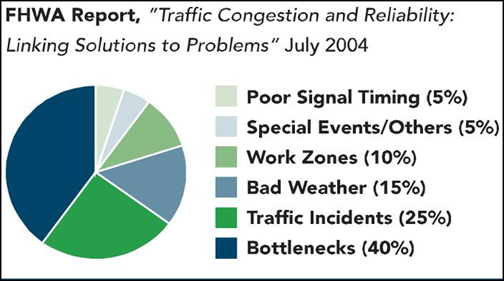
Road Network Operations
& Intelligent Transport Systems
A guide for practitioners!

Road Network Operations
& Intelligent Transport Systems
A guide for practitioners!
Traffic Management refers to the combination of measures that serve to preserve traffic capacity and improve the security, safety and reliability of the overall road transport system. These measures make use of ITS systems, services and projects in day-to-day operations that impact on road network performance.
Central to this approach is the development and integration of a set of traffic management measures appropriate to the local and regional requirements – and to achieve this through a planning process that makes use of systems engineering, standardisation and documentation, and performance management.
The emergence of ITS in the field of traffic control has enabled a number of new concepts to be applied in the framework of innovative operational systems. Examples include bus and tram priority, and pollution monitoring. These features are starting to be deployed amongst established traffic management systems.
When traffic control systems have been found to reach their limits and where adding capacity or new building of road infrastructure is not feasible, further measures may become necessary. These may include restrictions on the free use of individual vehicles through Electronic Road Pricing (ERP) or a Congestion Charge. (See Congestion Charge)
Some examples of traffic management measures that may feature as part of a network operating strategy are:
Some years ago, a study in the USA set out to quantify the leading causes of traffic congestion. The results, averaged for all roadways, are shown in the Figure below. A large proportion is attributable to road bottlenecks and poor signal timing (40% and 5% of all congestion in this example). This congestion is repeated on a daily or weekly basis and is referred to as recurring congestion.
Although the data shown in the figure below is particular to the USA, the high incidence of bottlenecks points to issues of network management and infrastructure inadequacies. This is the case particularly at road intersections and junctions, and can be seen across the world. Extensive traffic management measures are deployed to address these problems. The proportions in the figure are composite estimates derived from many past and ongoing congestion research studies. They can be considered as enduring proportions as they continue to feature in the current equivalent (2015) FHWA publication

As the figure shows, the leading cause of non-recurring congestion is traffic incidents. Nearly all of non-recurring congestion can be mitigated by better operational strategies. Even with bad weather, ITS can help with mitigation. Dealing with more severe emergencies usually presents orders of magnitude in challenges – but again, better operational planning, preparation and response can help mitigate many of their impacts.
Programmes that seek to minimise non-recurring congestion include the coordination of regional road network operations, traffic incident and emergency management, work zone management, road weather management and roadway ITS maintenance operations. Other approaches to congestion mitigation include traffic control and demand management. (See Traffic Control and Demand Management)
Specific guidance on a number of traffic management services have been developed by European road authorities and operators as part of the European “EasyWay” project. The EasyWay ITS deployment guidelines are available for download at http://dg.easyway-its.eu/DGs2012
The Chartered Institution of Highways & Transportation (UK) Network Management Notes cover a number of traffic management topics and are available for download at http://www.ciht.org.uk/en/knowledge/standards-advice/network-management-notes/index.cfm
The publication "Green and ITS" has a useful chapter on Traffic Management. (See Green and ITS)